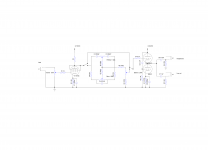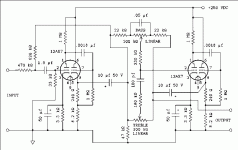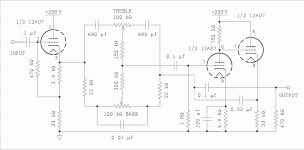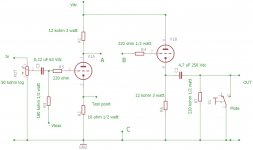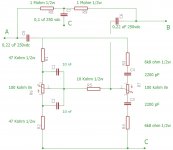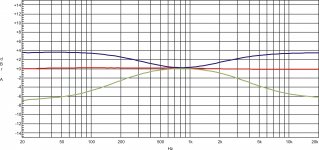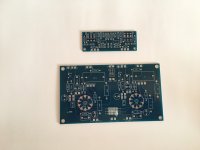Any suggestions on improvement would be great, I know its not going to be perfect.
I drew this up based on the svetlana design using an EF86 strapped as a troide for the first gain stage and I decided to insert a tone circuit and balance control with a bypass switch.
(see 6th Street Bridge: Triode Connected EF86 linestage and headphone amplifier )
This is where it got a bit muddy for me, I am not sure I have got this part correct, its based on the Baxandall design. I get the feeling I may need to insert a coupling cap somewhere in here
Im also looking if the final gain stage can easily be modified to suit an ECC83/12AX7 instead of an ECC88/6922.
While I dont intend to use headphones anytime soon, it would be nice to have it work well with them since im going to the trouble of this build.
The link notes that it really only suits high impedance headphones, I dont know how expensive and/or common these types are.
Anyway, here is the schematic:
I drew this up based on the svetlana design using an EF86 strapped as a troide for the first gain stage and I decided to insert a tone circuit and balance control with a bypass switch.
(see 6th Street Bridge: Triode Connected EF86 linestage and headphone amplifier )
This is where it got a bit muddy for me, I am not sure I have got this part correct, its based on the Baxandall design. I get the feeling I may need to insert a coupling cap somewhere in here
Im also looking if the final gain stage can easily be modified to suit an ECC83/12AX7 instead of an ECC88/6922.
While I dont intend to use headphones anytime soon, it would be nice to have it work well with them since im going to the trouble of this build.
The link notes that it really only suits high impedance headphones, I dont know how expensive and/or common these types are.
Anyway, here is the schematic:
Attachments
Ignoring all else (good, bad, or indifferent), that setup has a problem with the listening level changing whenever the tone shaping circuitry is inserted/removed.
IMO, tone controls that can be totally removed from the signal path, when not in use, is correct. Few recordings benefit from the presence of tone controls and the sonic damage they can inflict on good recordings can't be ignored.
Really good tone controls are not simple, as the provided Max Robinson setup illustrates. It's "unity" gain and does not alter the listening level with insertion/removal. Two bottles per channel for an infrequently employed feature is (IMO) extravagance. The bottle count can be reduced to 1/channel by replacing the cap. coupled cathode followers with DC coupled ZVN0545A source followers.
IMO, tone controls that can be totally removed from the signal path, when not in use, is correct. Few recordings benefit from the presence of tone controls and the sonic damage they can inflict on good recordings can't be ignored.
Really good tone controls are not simple, as the provided Max Robinson setup illustrates. It's "unity" gain and does not alter the listening level with insertion/removal. Two bottles per channel for an infrequently employed feature is (IMO) extravagance. The bottle count can be reduced to 1/channel by replacing the cap. coupled cathode followers with DC coupled ZVN0545A source followers.
Attachments
Yes you need a coupling cap after the bypass switch, and a couple of resistors to bias the upper tube.
It looks like you're trying to build a white cathode follower, so you also need a small resistor in series with the anode of the upper tube.
You can't drive headphones with a 12AX7.
It looks like you're trying to build a white cathode follower, so you also need a small resistor in series with the anode of the upper tube.
You can't drive headphones with a 12AX7.
Is there any objection to move the TC to the input of the amp?
It gets rid that problem which Eli mentioned at the beginning of his response.
You perhaps have to alter the gain of the first stage.
It gets rid that problem which Eli mentioned at the beginning of his response.
You perhaps have to alter the gain of the first stage.
The tone control stuff has insertion loss "baggage", regardless of where it's placed in the chain.
Max Robinson's sophisticated implementation of Baxandall style counterbalances the losses with an appropriate amount of gain.
I like the idea of Max's fully defeatable signal shaping at the very I/P. That simplifies insertion/removal and everything else.
Max Robinson's sophisticated implementation of Baxandall style counterbalances the losses with an appropriate amount of gain.
I like the idea of Max's fully defeatable signal shaping at the very I/P. That simplifies insertion/removal and everything else.
Ignoring all else (good, bad, or indifferent), that setup has a problem with the listening level changing whenever the tone shaping circuitry is inserted/removed.
IMO, tone controls that can be totally removed from the signal path, when not in use, is correct. Few recordings benefit from the presence of tone controls and the sonic damage they can inflict on good recordings can't be ignored.
Really good tone controls are not simple, as the provided Max Robinson setup illustrates. It's "unity" gain and does not alter the listening level with insertion/removal. Two bottles per channel for an infrequently employed feature is (IMO) extravagance. The bottle count can be reduced to 1/channel by replacing the cap. coupled cathode followers with DC coupled ZVN0545A source followers.
Im not sure what the sentiment against tone controls is. It appears to be influenced by audiophiles who demand expensive amps with just a single knob and who prefer to mess around moving, raising or lowering speakers and reconfiguring their rooms like a friend of mine does, and he is never happy with how his setup sounds, always complaining every time i visit him and his room is always different every time I visit. All this could be avoided with the adjustment of a couple of knobs!
It was once the norm on all gear, going way back through the 50s, 60s, 70s and 80s, etc.
I always like to adjust the bass and treble to suit, and find some recordings are quite thin anyway, and if i dont want to disturb others, i can crank down the bass. I figured I can add a bypass anyway, and not worry, at the end of the day im wanting to build something true to the period of tube amps.
Anyway, it looks like the design i was using was based off a unity gain stage, but i swapped it out for the white cathode follower.
Since this is not working in a unity gain configuration, I may scrap the white cathode follower altogether and go with the schematic attached.Yes you need a coupling cap after the bypass switch, and a couple of resistors to bias the upper tube.
It looks like you're trying to build a white cathode follower, so you also need a small resistor in series with the anode of the upper tube.
You can't drive headphones with a 12AX7.
Its here for your reference and is what I had basically built off when inserting it into my design.
Practical Tone Controls.
Since it can only drive high impedance headphones, I think I will not worry and just use a dedicated headphone amp on the line out, should i need it.
The tone control stuff has insertion loss "baggage", regardless of where it's placed in the chain.
Max Robinson's sophisticated implementation of Baxandall style counterbalances the losses with an appropriate amount of gain.
I like the idea of Max's fully defeatable signal shaping at the very I/P. That simplifies insertion/removal and everything else.
See the sehematic below for a unity gain stage im considering. Main question is whats the easiest way to implement a bypass switch to this?
Also not sure where to insert a balance control, as I was wanting to bypass this, but not sure if this is too critical to bypass or not, as its essentially a volume pot.
Attachments
Last edited:
As Eli already wrote in an earlier response:
"Few recordings benefit from the presence of tone controls and the sonic damage they can inflict on good recordings can't be ignored."
In my setup I also bypass my James TC with switches. I designed it with two NPN's (emitter follower and gain stage) to compensate for the signal loss.
The question: "Main question is whats the easiest way to implement a bypass switch to this?" is solved it this way. See my circuit diagram of the amp I made. Perhaps wil publish some pictures but not sure if somebody at all is interested.
"Few recordings benefit from the presence of tone controls and the sonic damage they can inflict on good recordings can't be ignored."
In my setup I also bypass my James TC with switches. I designed it with two NPN's (emitter follower and gain stage) to compensate for the signal loss.
The question: "Main question is whats the easiest way to implement a bypass switch to this?" is solved it this way. See my circuit diagram of the amp I made. Perhaps wil publish some pictures but not sure if somebody at all is interested.
Attachments
Thats good to know, I didnt know such pots existed.MN taper balance controls insert 0 Ω, in the center detent position.
A common configuration is to wire the MN taper part in series with the log. taper volume control. The balance control comes 1st, in the part chain.
Hi
as wrote time ago, I have done this:
Is a simply and effiicent diagram
You can use or not the tone control.
Changing the tube you can have a similar gain.
The ECC88 with control or 6N6/6H30
And the pcb is connected with only 3 pad each channel
as wrote time ago, I have done this:
Is a simply and effiicent diagram
You can use or not the tone control.
Changing the tube you can have a similar gain.
The ECC88 with control or 6N6/6H30
And the pcb is connected with only 3 pad each channel
Attachments
Last edited:
- Home
- Amplifiers
- Tubes / Valves
- Will this linestage work?
